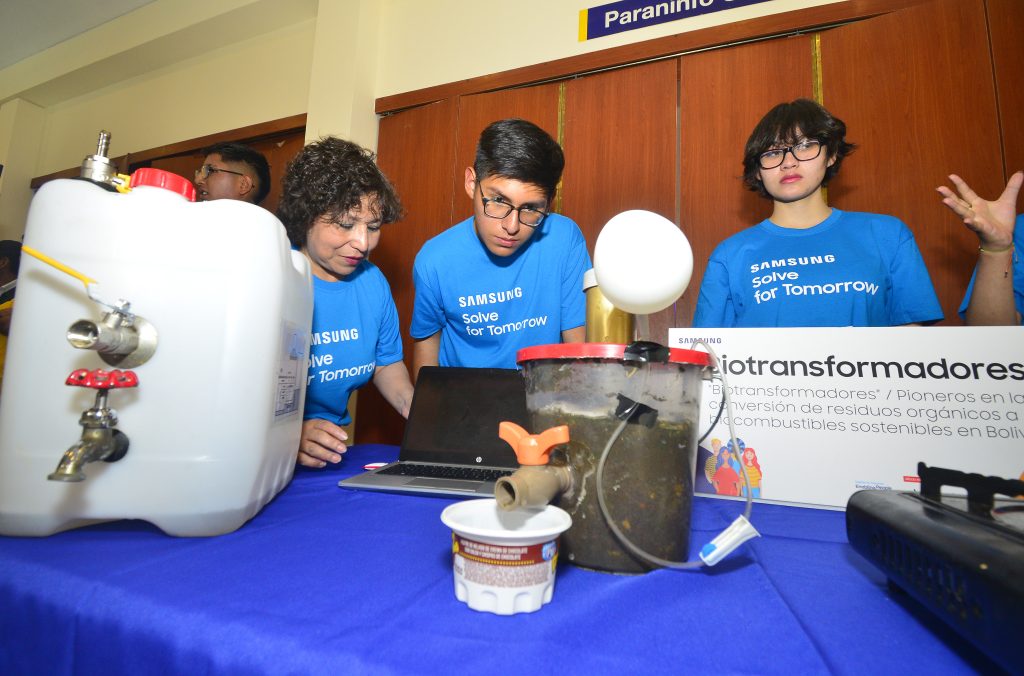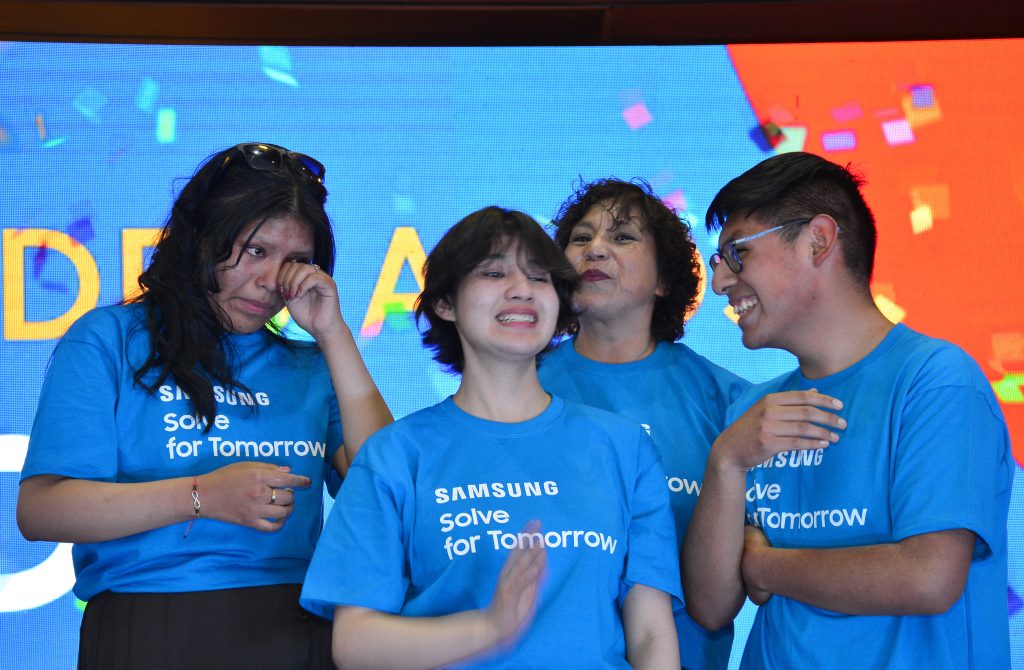Diversity is a value that can make the difference when it comes to creating creative solutions to collective problems. Young students with diverse personalities came together to address the issue of gas shortages in the Apaña community in La Paz, Bolivia. In this sense, they proposed the creation of a biodigester that transforms organic waste from plantations and livestock into biogas, irrigation water, and fertilizer, generating sustainable resources and avoiding waste.
The biodigester from the Biotransformadores team, winner of the Solve for Tomorrow 2024 Bolivia, was mediated by teacher Liliam Rocio Coronel Botello at the Reverendo Padre Walter Strub Educational Unit (UE). She issued an open call to create a STEM (Science, Technology, Engineering, and Mathematics) project with secondary education students, aged 14 and 15, which in Bolivia has a humanistic and technical focus. She was surprised when three young people, who weren’t very active in her classes, agreed to participate.
They were students with some learning difficulties and who didn’t find much space for expression, but needing just an opportunity to showcase their diverse skills. “I think that (the project) has been a catalyst for them to truly understand the importance of knowledge and study” Coronel reports.
The group was made up of young people with distinct personalities: shy, outgoing, cheerful, dreamy, and resilient. They were united by their desire to work in STEM for the first time, using the fundamentals of science to solve a problem directly affecting the communities where they lived.
Using a project-based learning methodology, the mentor teacher and the team chose their topic based on news reports announcing the decrease of oil and gas deposits in the country, causing rationing in the communities where students lived. The group also shared the idea of researching garbage as a raw material for biogas production. Thus, the idea of creating a biodigester made of simple and inexpensive materials was born.

There are many ways to build a biodigester: it generally consists of a container, such as a drum tank or water tank, where the hermetically sealed waste undergoes a decomposition process. One pipe carries the biogas. Another pipe holds the sticky, dark liquid, which is often used as fertilizer or irrigation water. The magic inside the container is done by anaerobic bacteria, microorganisms that are capable of surviving and multiplying in oxygen-free environments.
A biodigester made from waste, creativity, and mistakes
The team began extensive bibliographic research to build the biodigester prototype. The girls were responsible for theoretical research, such as ideal types of bacteria and waste. The boy in the group was responsible for researching the ideal materials to assemble the biodigester. Since the team had a lot of schoolwork during the day, they met in the evening via virtual meetings to present their findings.
It was within this small but determined group that the opportunity to collect waste also arose. One of the students lives in Apaña, a rural community near La Paz, and discovered that there was a large amount of waste from crops, cattle, and pigs. She also explained that the neighborhood already suffered from lack of gas deposits, and that the trucks doing delivery came only once a month.
With the territory and raw materials chosen, it was time to begin assembling the first prototype. “We don’t need to introduce any additional substances, just the remains of organic waste. It’s not just any garbage, and you can’t use eggshells, bones, or onion peels, for example, in organic waste, because they can kill the bacteria working inside the biodigester. And that’s the project. It’s that simple,” explains Coronel.
But building a functioning biodigester wasn’t easy. In the first prototype, built with a small plastic tank, the seal wasn’t complete, and the rotten waste gave off a foul odor. In the second attempt, a drum was chosen, but it had only one outlet on the original lid, which made the construction of the pipes complex. The prototype also didn’t work as the students hoped.
The team’s story was filled with frustration, but the professor encouraged them to continue their research and not to give up on the project. When the problem seemed hopeless and one of the students was considering giving up, the opportunity came to present the biodigester to the Chemistry Department at the Catholic University of La Paz.
With the help of an engineer, the third prototype was made from a drum with a larger lid to accommodate the taps and outlets. The third prototype was a success achieved through learning and error.
A biotransformation in the students themselves
“Against all odds, we continued,” recalls the mediator teacher. After mistakes, unpleasant surprises, and near-abandonment, the prototype was the winner of Solve for Tomorrow Bolivia 2024. The change in the students was impressive. “This has helped them mature a lot, and that’s what makes me happy. One of the students, for example, had a health problem and a lot of shyness. Now the student’s different, talkative with their classmates and always smiling”.
The school community supported the Biotransformers team’s work and even promoted healthy competition between them and a physics team that also participated in the Solve for Tomorrow program. “When we arrived at school with our prizes, the television we won for the unit, all the students were waiting for us,” Coronel recalls.

The internal changes were extraordinary. The three students improved their grades in virtually every subject, showed more interest in class, and were eager to participate in other extracurricular activities. The team’s determination inspired other students to begin STEM projects to solve problems affecting their communities. “We gained experience, we gained knowledge. We gained a lot from the project. It’s better if we encouraged the students. Working with young people is a beautiful experience,” Coronel concludes.




